Author: Marshall Schott
“You have your way and I have my way. As for the right way,
the correct way, and the only way… it does not exist.”
Nietzsche’s ideas resonate with me and in many ways have influenced my approach to this great hobby of homebrewing. Viewed as innovative by some and arrogant by others, some of us find great value in rethinking accepted principles of beer making and developing novel methods that simplify the process. I find it curious the attempt by many brewers to model their systems and processes after larger craft brewers who are limited in the methods they can use due to their batch sizes. I’d contend, in fact, that we have huge advantages over larger breweries precisely because of the options we’re able to use that are out of reach for them. And yet, there are those who will inflexibly opine that the only way to produce high quality beer is to use a 3 vessel fly-sparge setup. I even heard someone once say they would be able to tell the difference between the exact same recipes brewed using different methods, suggesting the fly-sparged beer would “taste crisper and cleaner.” Bullshit. It’s this kind of hogwash I find laughably embarrassing. Perhaps some just don’t want to accept that this beer making thing is actually very easy, requiring very little work, and that the money they’ve spent on their miniature version of a professional setup was unnecessary. Thankfully, a paradigm shift does seem to be happening in the homebrew world, likely influenced by the massive numbers of new brewers entering the hobby.
The pinnacle of easy beer making has to be Brew In A Bag (BIAB), a single-vessel method developed by those clever Australians that I believe has vastly changed the way many people view all-grain brewing. With little more than a kettle and a mesh grain bag, one can produce delicious beer without the use of extracts. It truly doesn’t get much simpler than this, so I had to try it out.
A couple things before I share my BIAB experiences. First, I still brew primarily using the batch sparge method, not only because it’s what I’m most familiar with, but because I often make 10+ gallon batches. With BIAB, difficulty appears to be linearly correlated to batch size. Second, I am a huge proponent of new brewers jumping right into all-grain and skipping extract brewing altogether. I know there are those that may take offense to this, I certainly mean none, but I have yet, in my 10+ years of making and consuming homemade beer, had an extract beer that didn’t taste like extract was used. Now, if that’s what you like, more power to you, go for it. Just please don’t use the argument that you don’t have the space or can’t afford to brew all-grain. With BIAB, you absolutely can go all-grain for minimal investment. I often recommend people start by making 1-3 gallon BIAB batches, which usually only requires the purchase of a bag, fermenter, and bottling supplies, as most people have a 4 gallon kettle lying around.
Back to my experience. For my first BIAB batch, I decided to throw together a 5 gallon Märzen recipe. I had previously purchased a large fine mesh grain bag that wasn’t getting much use and would do the trick. After collecting my entire water volume in the MLT/brew kettle, I milled my grain directly into the bag.
Using the BeerSmith software, I was able to precisely calculate the temperature of my strike water and once it was reached, I simply dropped in my bag of grains, gave it a good stir, and secured the bag to the rim of the kettle.
It looked and smelled like a typical mash, I figured something must be going right. Once my mash temp was stable, I covered my kettle and threw an old sleeping bag over the top for added insulation. This was sufficient since I was brewing on a 100°F day, during the winter it might be a good idea to be a little more thoughtful with your insulation. One of the great things about BIAB that I realized quickly is that if my mash temp fell, all I had to do was turn a burner on very low and stir for a few seconds to get it back up to where it should be. I only did this once after dropping 2°F in 40 minutes. Given the large volume in the kettle, it held temperature pretty well. Once my 1 hour mash was complete, I turned the heat on to raise the temp to 170°F for a mash-out step.
The wort looked like… wort. I checked my pre-boil gravity and was spot on with what BeerSmith predicted at 70% efficiency. This surprised me, as that was about the same efficiency I had been getting with my usual batch sparge process. I removed the bag, squeezed it a bit, and began my boil.
Everything proceeded from this point as it would with any other brew– add hops, chill wort, transfer to fermenter, pitch yeast starter, and control ferm temps. The finished beer was no different than any other beer I’d made, except for the fact it took me nearly an hour less to make and clean-up was a cinch. I was convinced.
A few months later I had the bright idea to pitch some wild yeast collected under a bush in my front yard into a small batch of beer. I didn’t want to use all my regular equipment for a 2 gallon batch, so I decided to do a small scale BIAB. My concern was maintaining my mash temp with such a small volume, so I decided to use a small cooler I bought to take on my boat.
I added my full volume of slightly overheated brewing liquor to the cooler, allowed it to preheat for a few minutes, dropped my bag of grains in once strike temp was reached, and closed the lid. An hour later, I returned to discover I’d lost 2°F, not too shabby if you ask me.
I then removed the bag of grains, squeezed it pretty aggressively, then poured the sweet wort from the cooler into a 4 gallon kettle to proceed with the boil.
Again, I hit my predicted numbers and all was well. Unfortunately, the finished beer didn’t fare as well… the yeast (and whatever other shit) I’d harvested from my front yard produced a terribly vegetal and allaround unpleasant beer. But it was a fun experiment!
When my brother-in-law said he wanted to start homebrewing in his small Berkeley apartment, I knew exactly what path to send him down. He has now made numerous beers using this method, even scoring well in a local competition with his Mild Ale, and he’s never touched extract, something he has no regrets about.
Common Misconceptions About BIAB
I’ve heard it said that full volume mashing leads to thin body and mouthfeel. I’m not sure where this idea came from, but it couldn’t be further from the truth. Body and mouthfeel are a function of mash temp and ingredients, not water to grist ratios, I’m not even sure what science there is to back this up. In my experience with no-sparge brewing, the beers actually seem to come out with a much more noticeable maltiness and fantastic mouthfeel.
Another misconception is that BIAB is significantly less efficient than fly or batch sparge brewing. While true to some extent, the reality is BIAB actually puts most brewers right where they need to be for the best wort to be produced, in the 70-75% range. One of the huge benefits of this is that the risk of tannin extraction from the grain husks is essentially eliminated. It’s interesting to me when homebrewers pride themselves on getting 90%+ efficiency, as they run a much higher risk of producing a beer with astringent off-flavors, and for what, a savings of a buck or two?
When I was reading up on BIAB prior to my first batch, a very common recommendation was to mill the grain super fine, with folks contending this would increase efficiency without risk because there is no actual sparge step. In listening to a recent interview with Pat Hollingdale, the Australian man who basically invented BIAB, on the great Basic Brewing Radio podcast, I learned this was an unnecessary step that could potentially lead to problems. Pat recommended utilizing a more standard crush size and mashing for 90 minutes as opposed to 60, explaining that the other methods actually extend beyond the 60 minutes due to the added time it takes to sparge. Sounds good to me.
Unfortunately, there remains some haughty homebrewers out there who look down on BIAB, or even batch sparge for that matter, assuming anything other than fly sparge brewing is childs play. It’s pathetic, if you ask me. Please do not let the concern of how others might perceive your brewing setup stop you from using this method, it works just as well as any other all-grain method. To those who do talk shit about methods other than the one you use: just stop it, you’re making a fool of yourself.
Many folks, especially homebrew shop owners it seems, argue that extract brewing is easier than all grain. I have to believe this is motivated at least some by the fact shops profit more off of extract than grain, which is cheap. Maybe I’m wrong. Trust me, brewing all grain, especially when using the BIAB method, is just as easy as brewing with extract. Plus you get full control over the recipe, as you won’t be relying on condensed wort that some company produced.
Pros and Cons of BIAB
The pros are obvious: low start-up costs, not much equipment needed, reduced time to brew, and the beer comes out great.
I’m having a hard time coming up with any real cons of BIAB, perhaps the fact you may have to monitor your mash temps a little closely at first, but even that’s not a big deal. Hmm…
Tips & Tricks for BIAB
– Add grains to strike water, not the other way around.
– If you’re brewing small batches, move your mash to an insulated cooler to help maintain your temp. My brother-in-law uses a large insulated lunch bag, it works great. If you use a regular ice chest, it might be a good idea to pre-heat it with some boiling water before putting your pot in.
– Get yourself some silicone heat-resistant gloves, they’ll allow you to squeeze your bag without burning yourself.
– Peruse BIABrewer.info, it’s a trove of fantastic information for BIAB brewers.
If you’re someone who has been looking to get into homebrewing or you’ve been brewing with extract and want to jump into all-grain, consider giving BIAB a go! It’s a great method that I’m sure will leave you wondering why you waited so long.
Cheers!

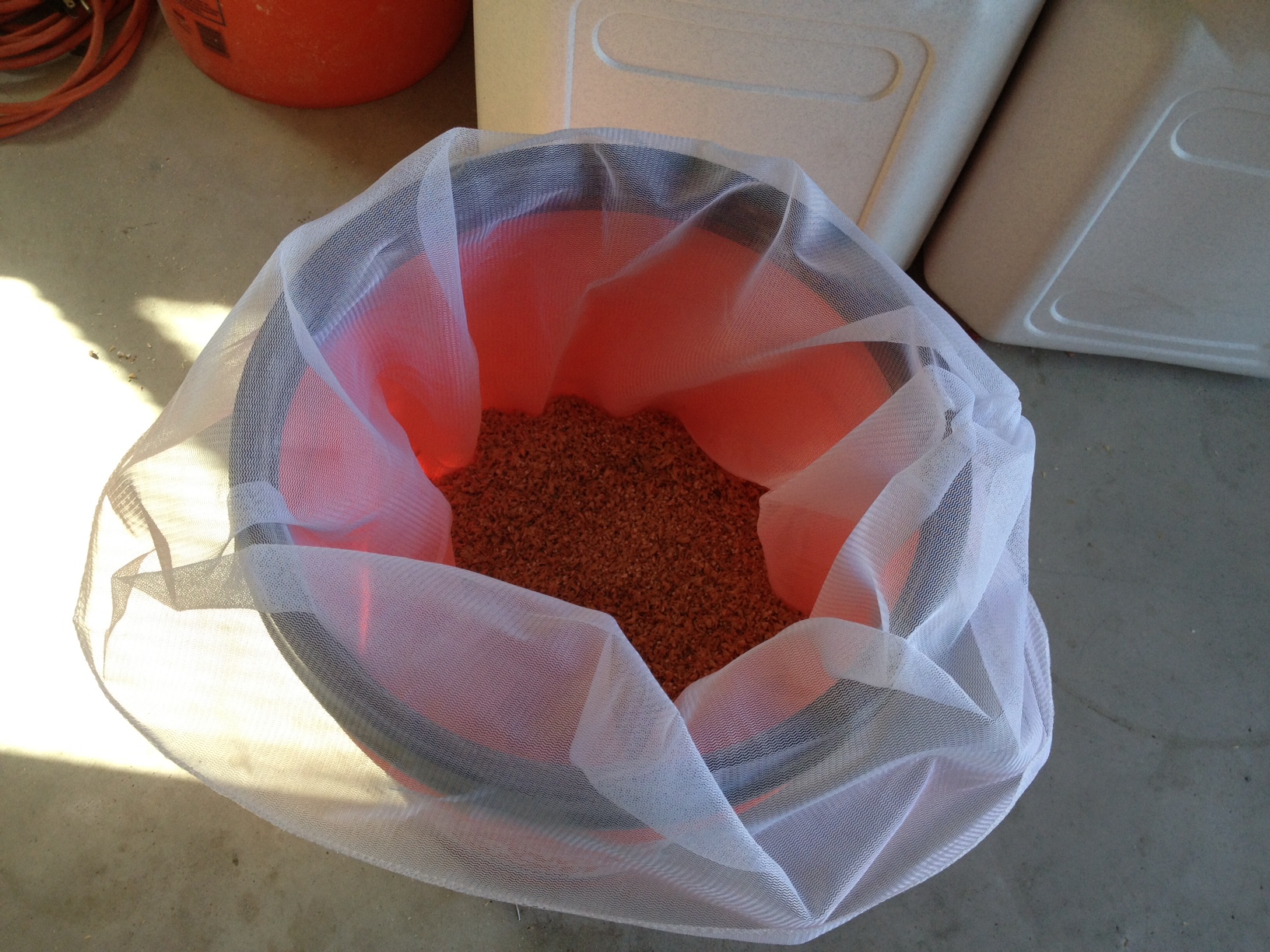
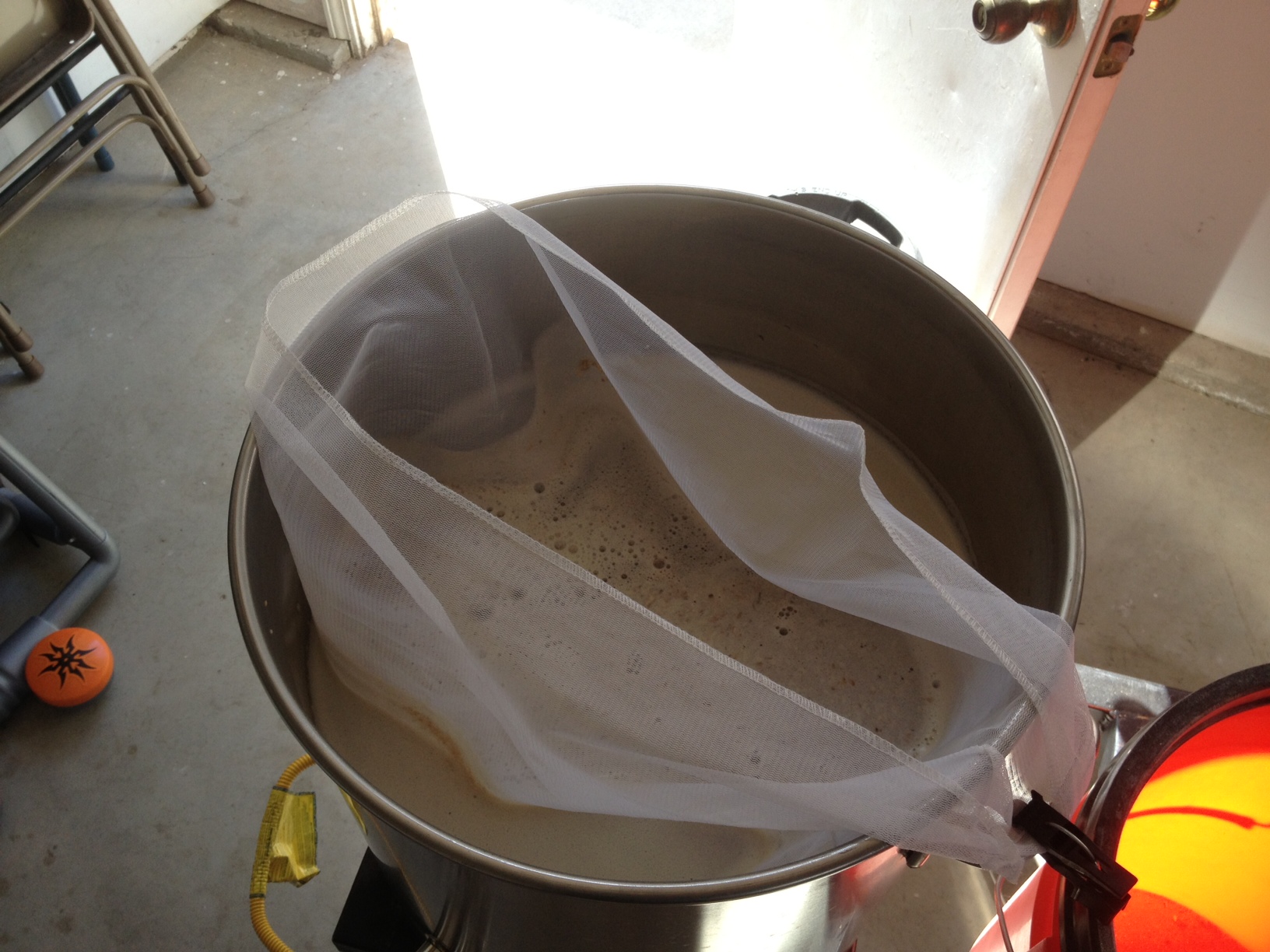


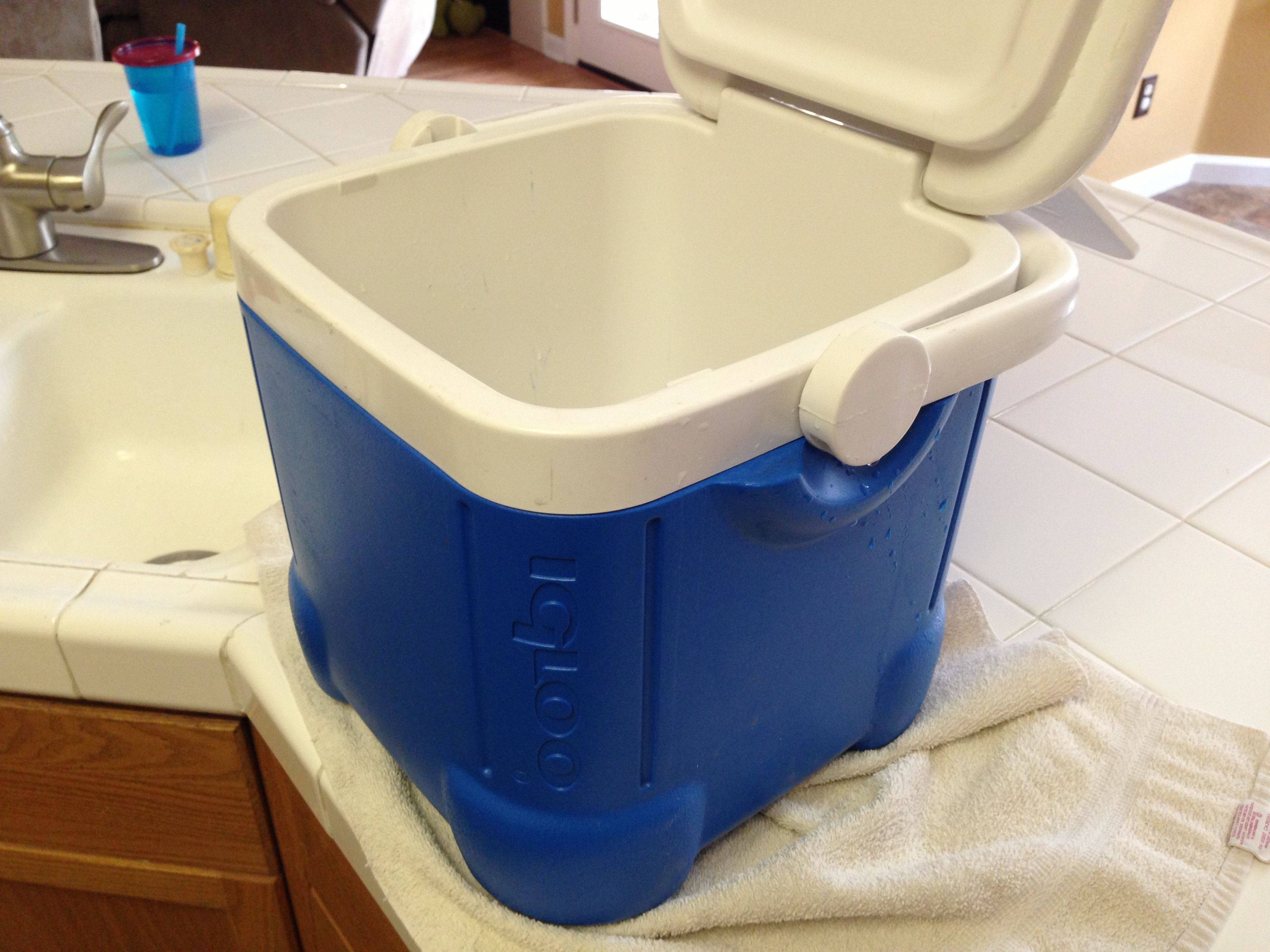
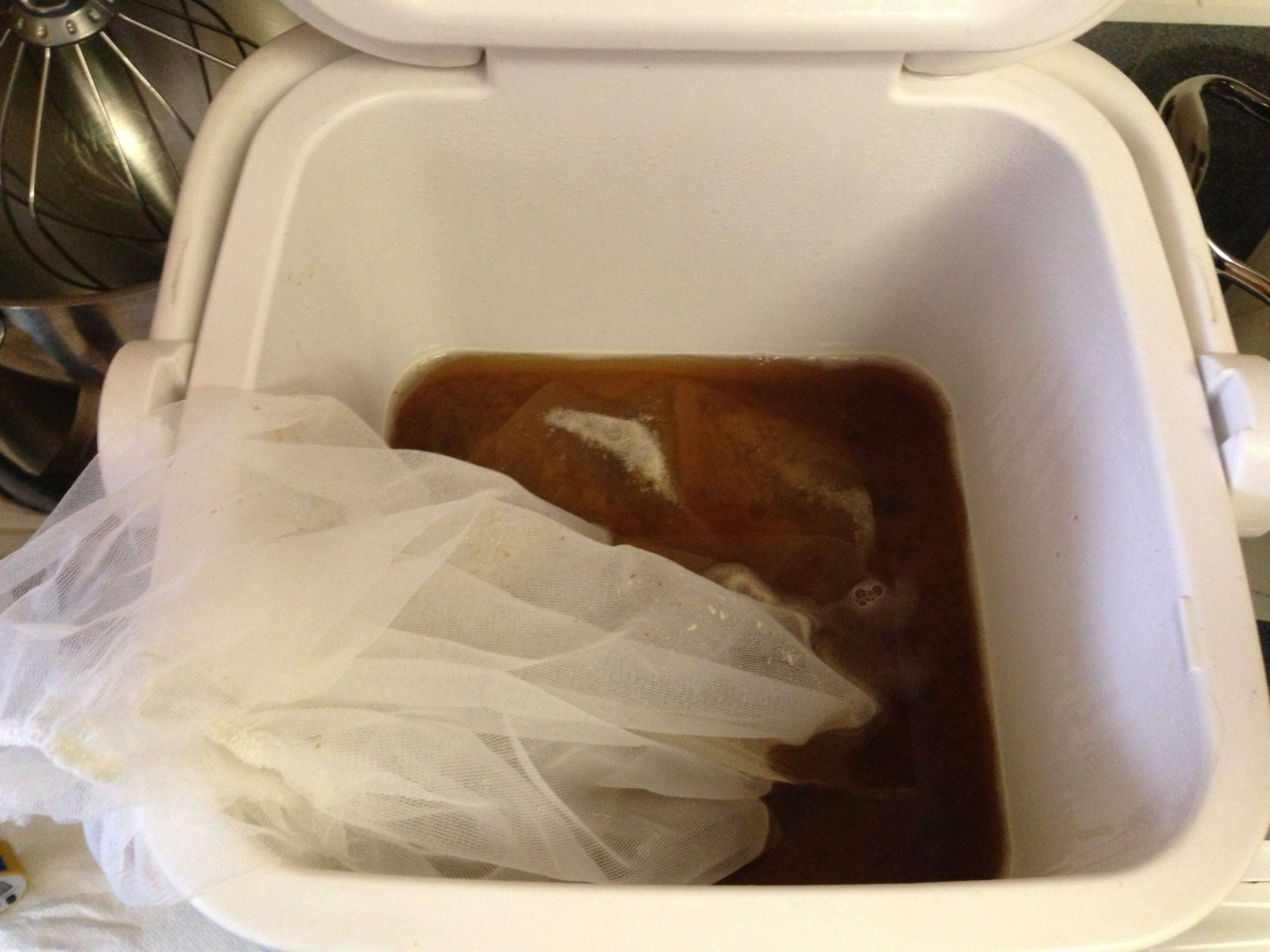
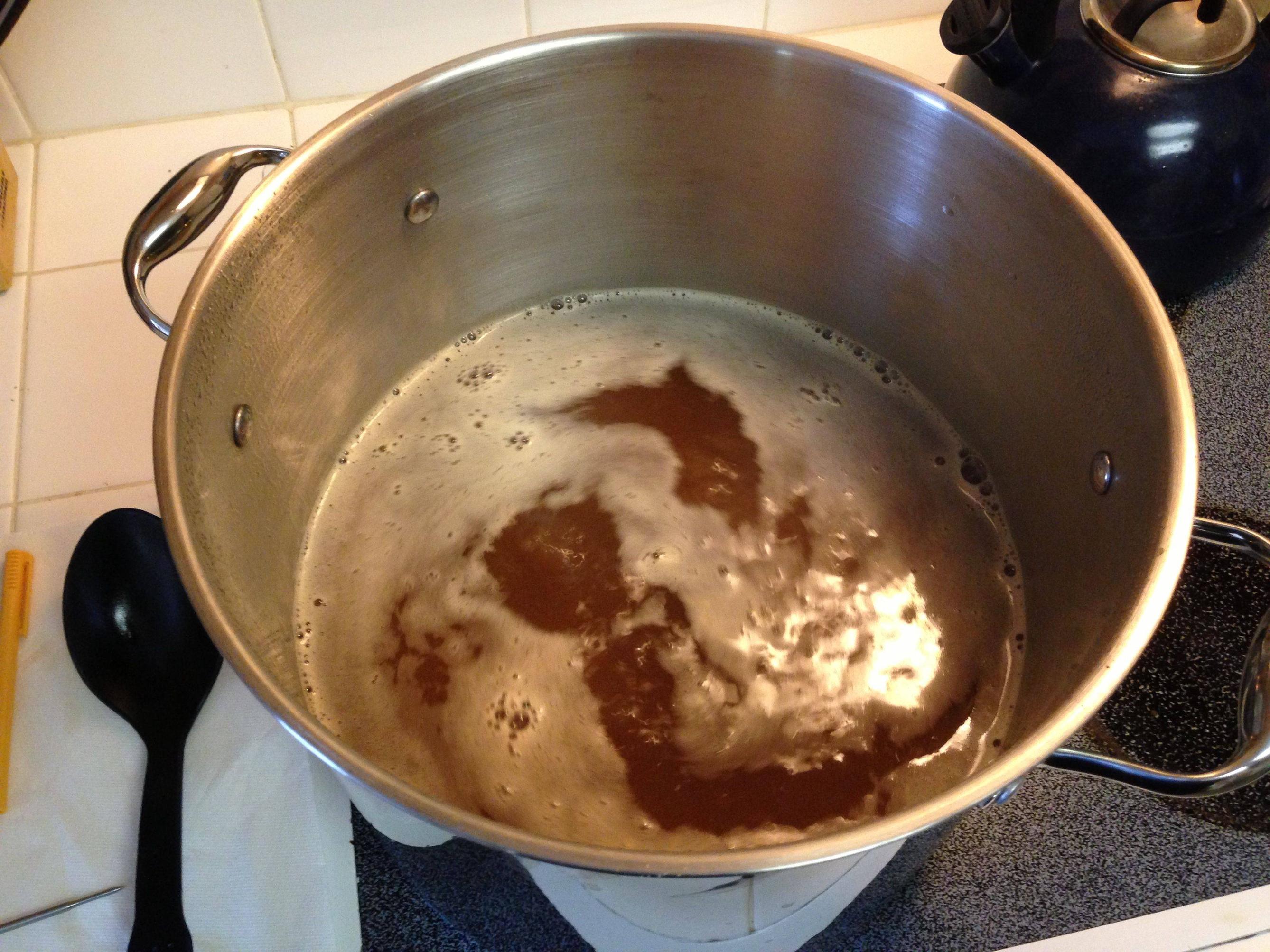








36 thoughts on “Brew In A Bag: All Grain Brewing Made Very Easy”
Perhaps the beer was bad because of this: http://www.homebrewtalk.com/f36/do-you-squeeze-bag-biab-177051/
I’ve had plenty of beer made using the BIAB method, most of which was squeezed like crazy, and they came out fine. The beer was bad because of the nasty yeast stuff I picked up from my yard. It wasn’t astringent at all, but tasted like a wild yeast infection.
Yep. Old wives tale. Squeeze away.
Nah. Old wives tale. Tannin extraction is a factor of temp and ph levels.
Reblogged this on Stainlessbrewer's Blog and commented:
Another great home brewing blog…check it out!
why on earth you would try to use anything under a bush in a front lawn is beyond me.
Have you any spirit?!?! It was just for fun, didn’t hurt anything, could have potentially found something cool/good.
Great post! I started brewing two years ago. My first batch was all grain, BIAB, and I haven’t looked back since. I love it! I also recently got to brew on a 3 vessel system, which was also lots of fun. But, I love the quickness and simplicity of my BIAB setup. I’m happy the method is picking up steam. I always tell friends who are looking into beer brewing not to be intimidated by all the technical crap home brewers may throw at them; brewing beer can be as simple, or as complex as you want it to be. Bottom line is, if you mash grain in water for about an hour, boil it, then ferment it four a couple weeks: BOOM. Beer. You can figure out the more complicated info later.
I am sick and tired of three vessel Brewers looking down their nose at brew in the bag. As if they do something special and different that makes the beer better. furthermore grain is grain hops are hops And water is water what you put in is likely what you get out. based on my tasting the brew in the bag beers are every bit as good if not better. the stupid stuff people say about brew in the bag is annoying like it will cost you a lot more in the long run and 50 % efficiency is normal. my favorite is the tannin same as if there are tannins from squeeze in the bag Yeah right
I also started out my homebrew hobby by jumping right in the BIAB all-grain brewing. I have had nothing but praise from everyone in my local brew club about how even my first beer was great and how impressed they were. In the past 2 years I’ve been brewing, several of the brewers from the local club have converted from 3 vessel to BIAB because of their exposure to it by me.
I have seen firsthand though the haughty, nose in the air, attitude of those 3 vessel brewers who think that BIAB is worthless. It’s mostly been on some of the popular online homebrew forums though. Some of my favorite misconceptions that I see repeated over and over are things like the tannin extraction from squeezing the bag (only caused by temp and ph), BIAB produces cloudy wort (P.S., it all clears in the fermenter), or the horrible efficiency myth (I have personally had a consistent 79-81% mash efficiency in the dozens of batches I’ve brewed so far).
Rock on BIABer’s! Keep proving them wrong.
I have done all 3 methods, and I much prefer BIAB for its simplicity and speed. My personal belief is that the quality of the end product has FAR more to do with fermentation/temp control and what you do with that than your mashing method. I believe several of the exBEERiments done on this site back up that statement. There’s lots of brewing “boogeymen” floating around out there that get thrown around that are nothing more than myths – keep knocking em down one by one Brülosopher 🙂
Excellent tutorial! I’ve been doing Partial Mash BIAB for several years now, and just this summer purchased an 8 gallon brewpot and started doing all-grain BIAB. Up until now, I always followed DeathBrewer’s tutorial from homebrewtalk.com, which was a 2-pot system that has you mashing in one pot and sparging in the other. I would use a 1.5 quarts per pound ratio in the mash tun, and heat up 2 gallons of sparge water in the other. I always opted to keep the temperature of the sparge water on the lower side, too, to get more conversion. I definitely think I’m going to try your method on my next brew, as a few of my recent beers have been very thin bodied, and hitting final gravitys much lower than expected, which leads me to believe I’m just losing too much heat. I think a single pot, 90-minute sparge might be the way to go.
Here’s my question: so you’re brewing a 5-gallon batch. But obviously you’re going to lose liquid from soaking in the grains, and then again during the boil. How do you account for all of that loss of wort when adding all of your water from the start? Let’s say you lose 1 gallon of water to the grains and another 1 gallon to the boil. Do you mash with 7 gallons of water then for a 5 gallon batch, or do you add top up water before you start the boil?
Er, I meant “single pot, 90-minute mash.”
I’m glad you liked the tutorial! I let BeerSmith do all the calculations for me, it accounts for grain absorption and boiloff rate.
So would you need a 10-gallon pot to do a 5-gallon batch then? I’m thinking if I added ~7 gallons of water and then 10-12 pounds of grain to my 8-gallon pot I’d end up with a lot of water on the floor.
It really depends on your SG, you could probably get away with 5 gallons of 1.055 beer in a smaller pot.
Any thoughts on the possibility of first wort hopping when using BIAB? I don’t fly sparge, and even with batch sparging it seems that the contact time with the hops during batch sparging wouldn’t be comparable to that you would get with fly sparging.
The only method I can think of would be to raise the wort temperature part way to boiling and hold it there for some arbitrary period of time, before ultimately bringing the wort to a boil. Would that even be worth the effort?
Im not sure it matters all that much. I would skip yhe mashout step, or toss the FWH charge in beneath the bag, then proceed as usual.
I’ve done first wort hopping with BIAB plenty of times. I tend to make brew days a fairly relaxed occasion, not strictly adhering to times (except the boil), or trying to get everything done asap.
All I do is lift the bag up to drain after mashout and set my urn to hold the wort at a certain temp (usually somewhere around the original mashing temp), go have some lunch or whatever, then come back and squeeze the bag out, move the bag out of the way, chuck in my hop spider with the FWH addition in it and crank the urn up to start bringing it to the boil.
Perhaps a silly question. Instead of mashing in an insulated cooler, can I mash in the kettle and keep a stable mash temperature using a heating element? I use an electric heating element from a turkey cooker for the boil. It has a thermostat, so I could set a required mashing temp and it would hold it automatically. What do you think?
Well, I always do BIAB in a kettle… and I think the heating element would work well!
Thanks. I was just concerned that a direct contact of the heating element with the grain may screw up the process, as the element itself is obviously warmer than the water in order to heat it up.
where do i get this heating element you speak of? brand?
This would be a great addition to my BIAB keggle. did you drill a hole in the kettle? or do you just drop it in?
am I correct that the only difference between biab and your no sparge method is you do a mash out with biab. what do a mash out do is it important to quality?
BIAB is usually done in a kettle, I no sparge in a cooler MLT.
yep but equipment aside the process is much the same apart from mash out? what is the purpose of a mash out and does it matter?
First I want to compliment you on What a great blog you have here. I am thouroughly enjoying all the good reading, and haved learned a lot. Me and my girlfriend have been brewing 5 gallon extract batches for almost 3 years now, and are finally ready to move on. We brew in a small kitchen on a newer electric stove, and figure that BIAB will be the way to go for our transition to all grain. We currently use a 5 gallon kettle but thinking of looking into a 71/2 gallon If it would work on our stove. Is it possible to do 5 gallon BIAB batches in a small kitchen with a kettle of that size without making to big of a mess?
Thanks so much for the support! The rule of thumb for BIAB is to use a kettle that’s twice the volume of your target batch size, for a 10 gal kettle for a 5 gal batch. Now, if you’re really into lower ABV beers or don’t mind finagling a simple sparge, I do think a 7.5 gal kettle can work.
Just to add to your great article. One con of BIAB is it must get difficult for larger batches. The bag will get heavy, more risk of it ripping apart and/or hurting oneself (I am thinking 10 gallons batches +). I have not yet tried it but I think it will be my winter time method as I cannot brew with the full gear inside and won’t do it at 0F degrees outside (Canada = cold winters). I think it will be a great way to try recipes quickly and cheaply (whilst keeping warm).
I’ve made many 10 gal BIAB batches, it works great, though the bag can get heavy… so I use a pulley!
Thank you for the tip with the silicone gloves, squeezeing the bag now feels like pure delight 😉
I made a tutorial on how to sew you own BIAB bag, check it out:
http://lukasholenweg.com/2017/02/15/make-the-best-biab-bag/
Up until now I’ve been extract brewing but having got that mostly sorted I’m looking to move up to the end-to-end process. BIAB really appeals in terms of minimising extra spend (and storage) on multiple pots, but having been doing lots of reading I’m puzzled by one thing.
Probably just me missing something obvious, but when I extract brew it’s on the stove top at a small boil volume, I have a 15L pot, so I start at around 12L and usually end up with about 10L post-boil, which I then top up to 20L with extra cold water in the FV before I pitch the yeast.
Everything I’ve read about BIAB suggests that it has to be done with full volumes – i.e. no top up water after the boil. Is there a reason for this, or could I go for the maximum water I think I could fit for mashing, lose a bit when I take the grain bag out then boil it down (as if it were extract) and then top up in the FV as normal?
@Andy I have the same question as you. I do my 5-gallon BIAB recipes on the stovetop and it’s a little easier to keep a vigorous boil with closer to 4 gallons of liquid. Then, after a short time with the immersion chiller, I top-up with a 3L near-freezing Arrowhead water jug to get to pitching temps. Only downsides in my mind are the potentials for slightly darker wort and slightly less hop utilization at the higher sugar concentration. One way to combat the former is to substitute some DME for grain and add as a late addition (e.g. 15 min before flame-out).
On a separate note, I’d like sometime to do a “simulated” decoction (no second vessel) by doing the step mash by direct heating, and then bringing all of the grain to a boil for a short period of time. Any thoughts about this?
Great article. You are a very good boy.
Not “looking down on BIAB” but the biggest drawback I see is clarity, unless you have some way to recirculate. Try making a blonde ale or even an APA with brew in a bag and then compare that to one where the wort was recirculated in a traditional mash tun. Huge difference in clarity. I have found I cannot get a clear beer with a brew in a bag without recirculating like I can using a traditional mash tun. If you are making wild ales or New England IPA’s and clarity doesn’t concern you anyway then by all means go for it. If you want clear beers you will not get there. Even with Irish moss and other clarifiers. There is a reason German brewers have been using vorlauf for hundreds of years. If you’ve ever done an all grain batch and recirculated, you’ve seen the garbage that collects on top of the grain bed. With BIAB, this is going through to your beer! I want to scale down to one gallon batches for a bit and BIAB seems like a good idea. But based on my results with 3 gallon batches I don’t want to do it without a small cooler or other vessel in which to recirculate. I’m working on it.
I do BIAB and get really clear beer. That said, we’ve done a couple xBmts that seem to indicate BIAB beers tend to retain some haze. Not sure what would cause this, but we have plans to find out!